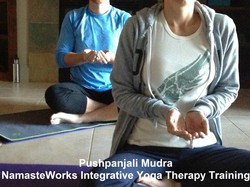 During the past weeks of class, we have been practicing the Pushpanjali Mudra during our opening time of breathing and centering. Pushpanjali means an offering of flowers. I picked this mudra because it is known for reducing stress and the lowering of blood pressure and aides in "releasing attachments at all levels of being" * while cultivating generosity. Pushpanjali is for "cultivating non-grasping - Aparigraha."* The Yamas are the first of 8 Limbs of Yoga. See my blog from September 2013 for more on the Limbs of Yoga: http://www.yogawithgrace.net/pams-blog/8-limbs-of-yoga . The Yamas are a list of ways we interact with others. Aparigraha (a-par-I-gra-ha) is the fifth Yama and is translated to mean non-grasping, non-coveting or non-possessing. The idea is to look at our lives and see where we hold onto stuff or yearn for stuff others have. "Stuff" is either physical things or more spiritual, internal stuff. As we look around at the things we posses we ask the question, do I really need it? What does it really do for me? Then we look inside to find what we might be holding onto, memories, hurts, titles, and more. These things we hold onto block us from really moving onto compassion and generosity. Practicing Aparigraha actually brings us to the point of interacting better with others. For example, if we covet something a friend has or does it blocks us from truly getting close to her. Practicing aparigraha, we would celebrate that she has a great job, blonde hair, or can crochet. When we aparigraha with our physical stuff, we find ourselves more able to let go off it and share it with others who do not have. When we practice aparigraha we celebrate that we can do the Tree Pose even when it looks a little different then the person next to us. The article "7 Ways to Practice Aparigraha" by Irene Petryszak is a great and easy read on how to practice Aparigraha. Irene lists and explains the following steps: Let It Go, Breathe, Practice Self-Care, Be Positive, Forgive, Practice, and Be Generous. The post "Aparigraha" on www.earthdancehealingarts.com is also focused on the practical aspects of Aparigraha. Jen explores how we can apply Aparigraha to many aspects of our lives including our yoga practice and our personal view of ourselves. Jen also lists some important questions to ask ourselves as we continue to practice Aparigraha. Give the article and the blog a read and let me know if you found them helpful. If you click on the green highlighted titles, the article and the blog with come up on a separate screen. Feel free to respond to this blog about your practice of Aparigraha. *from Mudras For Healing and Transformation by Josepha and Lilian Le Page Article on Pushpanjali: http://namasteworksyoga.com/pushpanjali-mudra-appreciate-life-just-as-it-is
0 Comments
Yesterday I posted a picture of the 8 Limbs of Yoga. The Niamas are the more personal and internal guidelines of living.
Svadhyaya is the Niamas that speaks about self study. It is looking inside and learning about ourselves. It is being honest about who we truly are. It is through our yoga practice, our times of quiet, prayer, meditation and just being open to listening and watching ourselves that we make discovers about ourselves. With these discoveries we grow and change becoming a better person. Some days our discoveries are very personal. Others days its just about discovering how to better serve ourselves so we function better. Last Wednesday I discovered a way to make myself work through my Wednesday evenings with more energy. I get home from work on Wednesdays around 6PMish. I give some attention to Neely (my cat) before putting away my work stuff and starting my usual Wednesday night house cleaning. Well...usually I find myself on the recliner, watching TV...feeling slow, and tired. Eventually, I get up and slowly and with great remorse, begin my cleaning. Meanwhile I munch on snacks, as I wait to eat with my husband at 9:30PM (ouch!). Last week, I did sit in the recliner, but this time with a good snack and my swim lesson and yoga lesson outlines (and the cat). I ate and worked on my lessons. When I had finished, I was relaxed, rested and nourished. I vacuumed with more energy and it went a lot faster (and less munching). I even had time to do a little yoga as dinner cooked! Today, I will try the same process as I feel this eating/relaxing/writing time really encouraged a more positive, energetic and productive me. Please share any of your self-learning experiences During Chair Yoga we began a conversation about Ahimsa.
Patanjali wrote the Yoga Sutras some 200 years after Jesus. These Sutras are guidelines to living and words of wisdom. It reads much like the book of Proverbs of the Bible. The Sutras contain the Yamas which are a list of ways of being that help us live well with others. The first Yama is Ahimsa. Ahimsa literally means "non-harming" or "non-violence". Ahimsa is about living with compassion in all that we do. It covers our physical actions, our conversation and our thoughts ." To practice ahimsa is to be constantly vigilant, to observe ourselves in interaction with others and to notice our thoughts and intentions." (from Beginning the Journey an article by Judith Lasater about yoga sutras.) During, I challenged everyone to compare Ahimsa with the Y's core values: caring, honesty, respect and responsibility and their faith values. What are the similarities? The other questions to ask is....where does ahimsa touch our lives? We will continue this conversation!!! Click on the button below to read the article by Judith Lasater. The beginning is a nice introduction to the Sutras. The articles continues with a few good paragraphs on Ahimsa. |
AuthorI enjoy yoga as it brings peace to my life. Teaching yoga has brought joy to my life and given me a chance to encourage others in learning yoga. Archives
July 2020
Categories
All
|
 RSS Feed
RSS Feed
